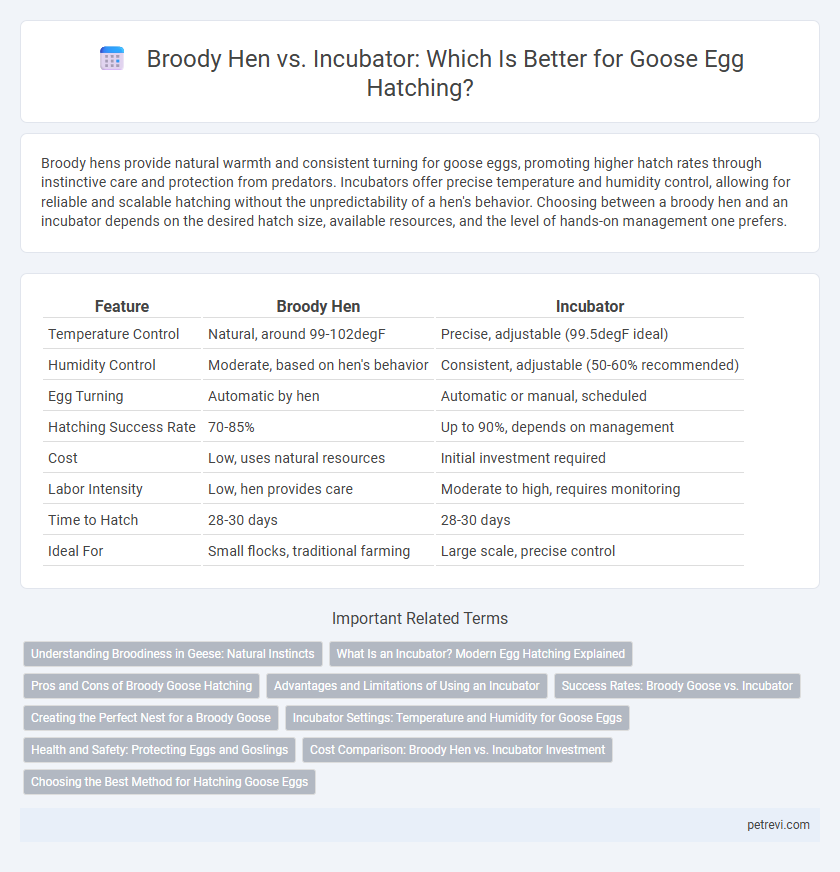Broody hens provide natural warmth and consistent turning for goose eggs, promoting higher hatch rates through instinctive care and protection from predators. Incubators offer precise temperature and humidity control, allowing for reliable and scalable hatching without the unpredictability of a hen's behavior. Choosing between a broody hen and an incubator depends on the desired hatch size, available resources, and the level of hands-on management one prefers.
Table of Comparison
| Feature | Broody Hen | Incubator |
|---|---|---|
| Temperature Control | Natural, around 99-102degF | Precise, adjustable (99.5degF ideal) |
| Humidity Control | Moderate, based on hen's behavior | Consistent, adjustable (50-60% recommended) |
| Egg Turning | Automatic by hen | Automatic or manual, scheduled |
| Hatching Success Rate | 70-85% | Up to 90%, depends on management |
| Cost | Low, uses natural resources | Initial investment required |
| Labor Intensity | Low, hen provides care | Moderate to high, requires monitoring |
| Time to Hatch | 28-30 days | 28-30 days |
| Ideal For | Small flocks, traditional farming | Large scale, precise control |
Understanding Broodiness in Geese: Natural Instincts
Broodiness in geese is a natural instinct where a broody hen will sit on eggs to provide warmth and protection, ensuring optimal conditions for embryo development. This behavior includes consistent incubation temperatures around 99 to 102degF (37 to 39degC) and periodic turning of eggs to promote healthy hatching. Understanding these innate characteristics is crucial when comparing the effectiveness of broody hens versus artificial incubators for goose egg hatching success.
What Is an Incubator? Modern Egg Hatching Explained
An incubator is a controlled environment device designed to replicate the natural conditions necessary for goose egg hatching, maintaining consistent temperature, humidity, and ventilation. Modern egg incubators use precise thermostats and airflow systems to optimize embryonic development, increasing hatch rates compared to traditional broody hen methods. This technology allows for large-scale goose egg incubation with predictable outcomes, reducing dependency on the hen's natural brooding behavior.
Pros and Cons of Broody Goose Hatching
A broody hen offers natural warmth and attentive care, increasing hatch rates through constant egg rotation and protection from predators, benefiting gosling health and development. However, broody geese tend to be less reliable in maintaining consistent temperatures compared to incubators, and environmental factors like weather can negatively impact hatching success. While incubators provide precise temperature and humidity control for large batches, the instinct-driven behavior of broody hens fosters stronger maternal bonding and early socialization among goslings.
Advantages and Limitations of Using an Incubator
Using an incubator for goose egg hatching offers precise temperature and humidity control, resulting in higher hatch rates and consistent results regardless of environmental conditions. Incubators allow for larger-scale hatching operations and minimize risks of predation or abandonment common with broody hens. However, they require significant initial investment, regular monitoring, and technical knowledge to prevent failures, while lacking the natural protective behaviors and warmth provided by a broody hen.
Success Rates: Broody Goose vs. Incubator
Broody geese exhibit natural temperature regulation and consistent turning of eggs, resulting in higher hatching success rates of up to 85-90% compared to incubators. Incubators provide controlled humidity and temperature, but improper settings or lack of turning can reduce success rates to around 70-80%. Broody hens also offer protective behavior that enhances gosling survival, contributing to overall better results in natural hatching.
Creating the Perfect Nest for a Broody Goose
Creating the perfect nest for a broody goose involves providing a quiet, draft-free area with ample soft materials such as straw or hay to mimic natural nesting conditions, encouraging the goose to remain comfortable and attentive to her eggs. Unlike incubators, which offer controlled temperature and humidity settings essential for consistent hatching success, a broody hen's instinctive warmth and natural turning of eggs promote strong, healthy gosling development. Ensuring proper nest sanitation and minimal disturbances increases hatch rates, making nest preparation a critical factor in successful broody goose egg hatching.
Incubator Settings: Temperature and Humidity for Goose Eggs
For optimal goose egg hatching in an incubator, maintain a temperature of 99.5degF (37.5degC) consistently throughout the incubation period. Humidity levels should be set at 55-60% during the first 28 days, increasing to 65-70% during the final three days before hatching. Proper control of these incubator settings ensures successful embryonic development and reduces the risk of hatchling mortality.
Health and Safety: Protecting Eggs and Goslings
A broody hen provides natural warmth and humidity levels essential for goose egg incubation, reducing the risk of temperature fluctuations that can harm embryonic development. Incubators offer controlled environments with precise temperature and humidity settings, minimizing contamination risks and preventing predation, but require constant monitoring to avoid mechanical failures. Both methods emphasize protection against bacterial infections and chilling, crucial for healthy gosling hatch rates and early immune system strength.
Cost Comparison: Broody Hen vs. Incubator Investment
Broody hens require minimal upfront costs, as they naturally incubate and care for goose eggs, making them a cost-effective option for small-scale hatchers. Incubators demand a higher initial investment, ranging from $100 to $500 depending on capacity and features, but offer precise temperature and humidity control, improving hatch rates. Over time, incubators may reduce labor and increase efficiency, but broody hens present the lowest ongoing costs without electricity or maintenance expenses.
Choosing the Best Method for Hatching Goose Eggs
Choosing the best method for hatching goose eggs depends on factors such as temperature control, humidity, and egg handling. A broody hen naturally provides consistent warmth and turning, increasing hatch rates while minimizing mechanical failure risks. Incubators offer precise environmental control and allow for larger batches but require careful monitoring to prevent temperature fluctuations and ensure proper humidity levels.
Broody Hen vs Incubator for Goose Egg Hatching Infographic

 petrevi.com
petrevi.com